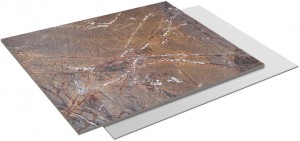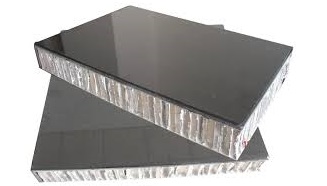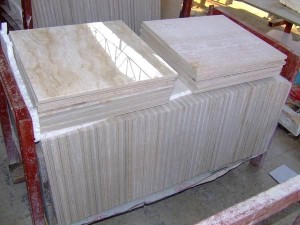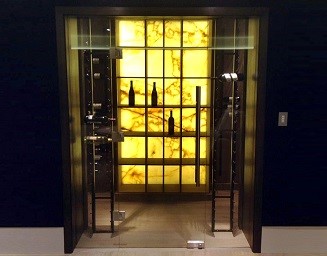Composite lightweight stone panels consist of thin sheets of natural stone veneer bonded to backing panels. Preserving the natural beauty of stone, composite panels overcome natural stones’ inherent characteristics and properties (heaviness, fragility, etc.) and are suitable for a wide range of interior/exterior applications.
Materials and Manufacture
Granite, marble and limestone; sandstone, slate and any other natural stone can be used in the manufacture of composite lightweight stone panels. Blocks of natural stone are cut into slabs (typically between 3 and 5 mm thick), then bonded to backing materials using high strength glue. Proper bonding throughout is ensured by the application of uniform pressure and heat. After the glue has set, panels are cut in half and polished/honed before being cut to customer specific shapes/sizes.
Types of Backing
Backing panels may, depending on the intended use, consist of polymer or honeycombed aluminium; ceramics, fiberglass or glass.
 Polymer Aluminium Backing – Ranging between 2.5 and 4 mm in thickness, polymer aluminium panels are lightweight, even and feature high resistance to chemical attacks and corrosion. They are particularly suitable for applications necessitating thinness and light weight (interior wall claddings; decorative ceilings, lift interiors, etc.)
Polymer Aluminium Backing – Ranging between 2.5 and 4 mm in thickness, polymer aluminium panels are lightweight, even and feature high resistance to chemical attacks and corrosion. They are particularly suitable for applications necessitating thinness and light weight (interior wall claddings; decorative ceilings, lift interiors, etc.)
Honeycombed Aluminium Backing – Especially suited for use with granite or marble, honeycomb panels range between 10 and 25 mm in thickness. The thickness of the applied stone veneer may be as little as 3 mm. In addition to its lightness, this backing features high strength and increased resistance to corrosion, fire and moisture, as well as providing good flexural strength and impact resistance. These properties make honeycombed aluminium backed composite stone panels perfect for counter-tops and interior/exterior wall claddings.
Ceramic Backing – Often used in the production of marble-finish composite lightweight stone panels due to the softer, open-vein characteristics of marble, ceramic backing is especially useful for flooring applications. Typically consisting of ultra-thin (3 mm) marble veneers bonded to 8 mm thick ceramic backing, composite tiles may be installed by mechanically anchoring (wall claddings) or cementing them (flooring). While ceramic backing provides a strong base, it is somewhat heavier than other backings.
 Glass Backing – Composite lightweight stone panels using glass backing are formed by bonding the stone veneer to either laminated or tempered glass using translucent epoxy, which will not affect the stone’s natural colour. Notably suitable when working with translucent onyx, white marble or alabaster, as the stone’s natural vein pattern will be transparent and glitter under lighting, glass-backed composite lightweight stone panels are often used in hotel elevators, prosceniums and ornamental ceilings; feature walls and similar applications.
Glass Backing – Composite lightweight stone panels using glass backing are formed by bonding the stone veneer to either laminated or tempered glass using translucent epoxy, which will not affect the stone’s natural colour. Notably suitable when working with translucent onyx, white marble or alabaster, as the stone’s natural vein pattern will be transparent and glitter under lighting, glass-backed composite lightweight stone panels are often used in hotel elevators, prosceniums and ornamental ceilings; feature walls and similar applications.
Fibreglass Net Backing – Most suitable as a backing for granite, fibreglass net backing has the advantage of being strong, lightweight and stiff. Composite stone panels using this type of backing can be installed either by mechanical fastening or use of adhesives.
Advantages of Composite Lightweight Stone Panels
Light Weight – Significantly lighter than solid stone, composite lightweight stone panels reduce a building’s dead load, making it possible to use stone where structural requirements may otherwise prohibit use of stone. The light weight also makes handling panels easier, increasing installation speed and thereby saving time and labour. Due to their lightness, composite lightweight stone panels can also be installed over any existing surface without time-consuming, costly remedial works and on any substrate by use of comparatively inexpensive methods like adhesives; interlocking channels or concealed screws.
 Strength and Flexibility – By reducing the natural stone’s brittle, fragile properties and thus providing greater impact resistance and flexural strength, the backing process not only makes composite lightweight stone panels suitable for a wide range of architectural applications, it also significantly reduces the risk of chipping/breaking during shipping and installation. What’s more, it also minimises the risk of warping (a natural characteristic particularly found in longer stone panels) and offers greater resistance to moisture/water penetration. This, of course, is decidedly important when dealing with limestone, travertine and other open structured types of stone.
Strength and Flexibility – By reducing the natural stone’s brittle, fragile properties and thus providing greater impact resistance and flexural strength, the backing process not only makes composite lightweight stone panels suitable for a wide range of architectural applications, it also significantly reduces the risk of chipping/breaking during shipping and installation. What’s more, it also minimises the risk of warping (a natural characteristic particularly found in longer stone panels) and offers greater resistance to moisture/water penetration. This, of course, is decidedly important when dealing with limestone, travertine and other open structured types of stone.
Stone Utilisation – Composite lightweight stone panels maximise natural stone usage (a single cubic-metre of raw stone can produce as much as 135 m2 of lightweight composite stone panels, but will only produce 45 m2 of solid stone panels). This:
- Reduces natural resource exploitation
- Promotes environmental conservation
- Provides end product with more consistent texture/tone
- Reduces cost/square metre (especially when dealing with expensive stones like sky blue granite or onyx marble, for example)
Offering unlimited design potential, properly sourced composite lightweight stone panels installed by fully trained professionals are a cost-effective, naturally beautiful and environmentally friendly; strong and long-lasting alternative to solid stone panels.



